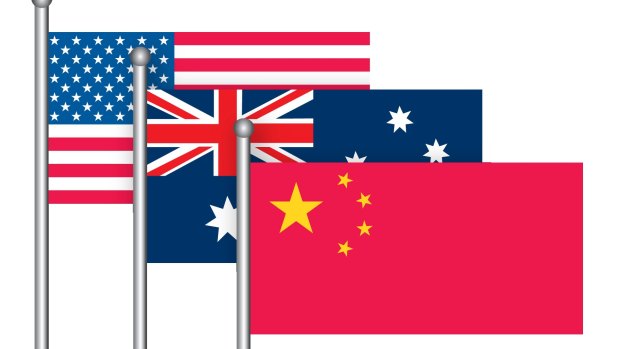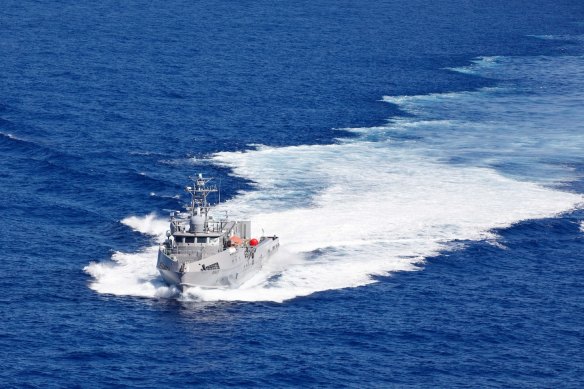This was published 1 year ago
Opinion
Who’s to blame for Australia’s big new security nightmare? Our closest ally
Anne Hyland
Senior CorrespondentAustralia has a growing security nightmare in the Pacific region, and America’s political dysfunction is making it worse.
Consider the Marshall Islands, Palau and the Federated States of Micronesia. Those nations, dotted with palm trees and surrounded by turquoise waters, sit to the north and north-east of Australia. They are strategically located between China, Japan and the United States – three of the world’s four largest economies – but sit closest to Australia.

Australia’s caught in the middle between China’s expansion in the Pacific and the growing concern about the United States’ commitment to protecting the region. Credit:
Presently, those Pacific nations are embroiled in a row with the US, which escalated last month when their leaders warned in a letter that it was pushing them into the arms of China.
The US has a treaty with those three countries known as the Compacts of Free Association agreements [COFA]. It guarantees the US exclusive military access to their territories and surrounding waters. In return for those military rights, the US provides them $US7 billion ($10.7 billion) in financial assistance over 20 years.
The US has had a military base on the Marshall Islands since World War II, and it’s where the Ronald Reagan Ballistic Missile Defence Test Site is located. On Palau, a new radar system for the US Air Force is being built.
The COFA treaty was signed off last year, but the funding has been delayed in the lead-up to the US presidential election because of political point-scoring between Republicans and Democrats. The COFA funding was supposed to be included in the National Defence Authorisation Act, but was removed to save money.
In February, the leaders of those three Pacific nations sent a letter to American lawmakers stating the stalled funding had created “opportunities for economic exploitation by competitive political actors in the Pacific”. Alan Tidwell, the director of the Centre for Australian, New Zealand and Pacific Studies at Washington’s Georgetown University, says it was a strong rebuke of the US.
“They’ve implicitly threatened, we’ll throw our lot in with the Chinese,” he observes.
While the letter was a clear negotiating tactic, it also points to those countries’ desperation. It got the attention of the US Defence department, which has become even more vocal about the issue, and it prompted the Australian and New Zealand ambassadors to the US to weigh in.
On February 22, Kevin Rudd and his New Zealand counterpart, Bede Corry, wrote to the congressional leadership expressing their concern about the delayed COFA funding.
“The US has said on multiple occasions that it wants to refresh, renew and re-engage with its partnerships in the Pacific, so it goes to the issue of credibility,” explains James Batley, a former high commissioner to the Solomon Islands and Fiji, and a former deputy secretary of the Department of Foreign Affairs and Trade. “You’ve got to put your money where your mouth is.” Batley is now a distinguished fellow at the Australian National University’s Department of Pacific Affairs.

A US naval vessel in the Pacific Ocean during a training exercise last year.
The Pacific has always been a strategically vital region for Australian trade and security. The US presence in the Marshall Islands, Palau and the Federated States of Micronesia has acted as a counter to Chinese military expansion. It has also helped contain China as it ramps up its economic and political engagement in the region, which has grown exponentially under the leadership of Xi Jinping.
China’s presence has grown through aid, investment programs such as the Belt and Road Initiative, a security pact with the Solomon Islands, and the provision of policing services in nations from Kiribati to Papua New Guinea and Fiji. As well, China’s leadership has secured agreements from Nauru, Kiribati and the Solomons to sever diplomatic ties with Taiwan as part of its One-China policy.
At the same time, Australia has been active in deepening its engagement in the region through aid, infrastructure spending and a labour-mobility scheme, which makes it easier for workers from the Pacific region to gain employment here.
The Pacific receives by far the largest slice of Australia’s foreign aid budget. The Lowy Institute says Australia spends 38 per cent of its aid budget on the Pacific, which has increased from 28 per cent in 2010. Back then, the Pacific received the same amount of aid as South-East Asia.
The rise for the Pacific has come at the expense of South-East Asia, which is experiencing its own problems with an increasingly assertive China. In the Philippines, territorial disputes have led to intensifying clashes between Chinese and Filipino maritime forces.
In an address to the Australian parliament on Thursday, Philippines President Ferdinand Marcos jnr gave an extraordinarily frank speech, in which he warned the rules-based order of the region that had existed since World War II, along with the peace and stability it had delivered, were at risk.
It was another reminder of why Australia should be concerned that the US is too distracted by domestic politics.
Anne Hyland is an award-winning writer and a senior correspondent for The Sydney Morning Herald and The Age.